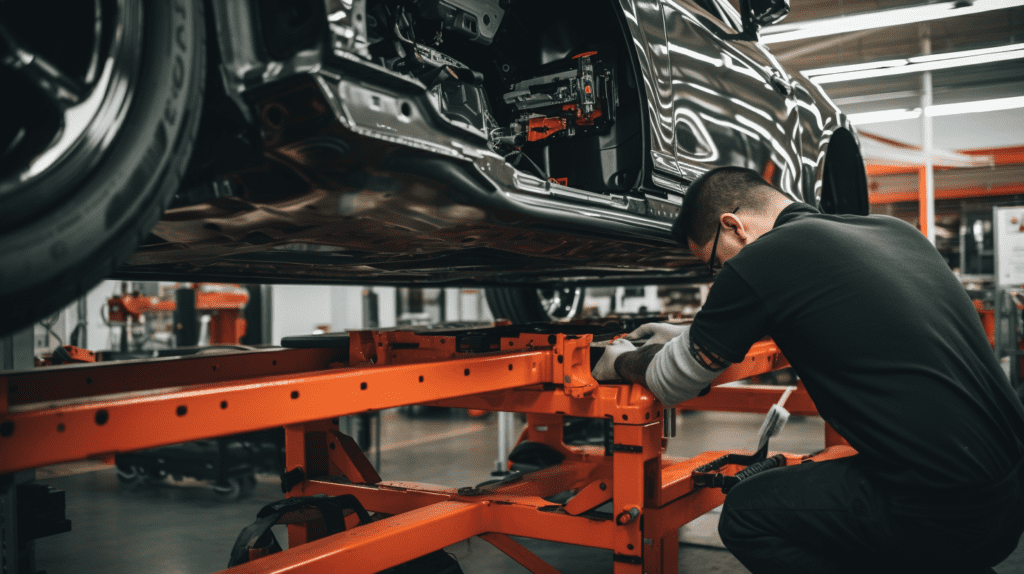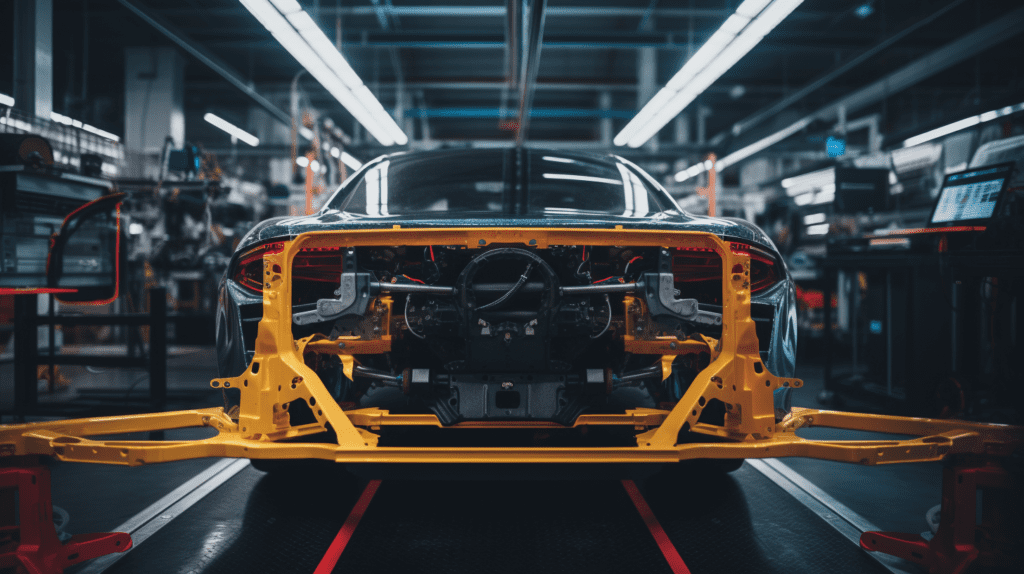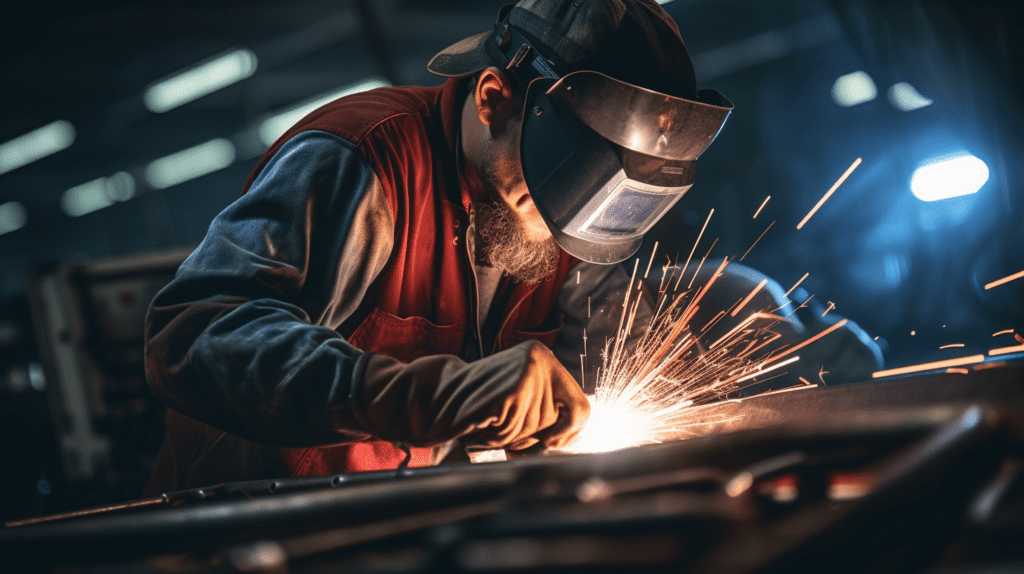Automotive Frame Straightening

Imagine a vehicle as a puzzle, with each piece fitting perfectly into place. But what happens when the frame gets bent or damaged? That’s where automotive frame straightening comes in. We, as professionals in the industry, understand the importance of restoring the structural integrity of a vehicle. In this article, we will explore the signs of a damaged frame, the process of frame straightening, and the benefits of entrusting this task to the hands of skilled technicians.
Key Takeaways
- Frame straightening is essential for ensuring the structural integrity and safety of vehicles after a collision.
- Signs of a damaged vehicle frame include uneven gaps between doors, misaligned body panels, visible damage in the frame, and suspension issues.
- The process of automotive frame straightening involves thorough inspection, use of diagnostic tools, hydraulic presses, and specialized pulling equipment.
- Professional frame straightening offers precision, time efficiency, insurance compliance, long-term reliability, and cost-effective solutions.
The Importance of Frame Straightening

Frame straightening is essential for ensuring the structural integrity and safety of vehicles after a collision. When a vehicle is involved in an accident, the force of impact can cause the frame to become misaligned or bent. This can have serious consequences, as it can affect the overall stability and performance of the vehicle.
One important aspect to consider when it comes to frame straightening is the cost. The process of aligning and straightening a vehicle’s frame requires specialized equipment and skilled technicians. Therefore, it can be a costly procedure. However, the cost of not straightening the frame can be even higher. Ignoring frame damage can lead to further problems down the line, such as uneven tire wear, suspension issues, and compromised safety.
When it comes to the role of insurance in frame straightening, it is important to note that many insurance policies cover the cost of repairs, including frame straightening, as long as the damage was caused by a covered event. This can provide peace of mind for vehicle owners, as they can rely on their insurance to help cover the expenses associated with frame straightening.
Signs of a Damaged Vehicle Frame
Often, we may not realize that our vehicle’s frame has been damaged in a collision until we notice certain signs indicating the need for frame straightening. It is important to be aware of these signs to ensure the safety and structural integrity of our vehicles. Here are four common signs of a damaged vehicle frame:
- Uneven gaps: If you notice that the gaps between the doors, hood, or trunk lid are uneven or inconsistent, it could be a sign of frame damage. A warped or bent frame can cause misalignment, resulting in these uneven gaps.
- Misaligned panels: When the vehicle frame is damaged, it can cause the body panels to become misaligned. Look for panels that don’t line up properly or appear crooked. This can indicate that the frame has been compromised.
- Visible damage: Obvious signs of damage, such as cracks, creases, or buckling in the frame, are clear indicators of frame damage. These damages can weaken the structure of the vehicle and should be addressed promptly.
- Suspension issues: A damaged frame can affect the suspension system, leading to problems with handling, steering, and tire wear. If you experience excessive bouncing, a bumpy ride, or uneven tire wear, it could be a result of frame damage.
To prevent frame damage in your vehicle, it is crucial to avoid common causes such as collisions, hitting large potholes or curbs, and off-roading. Additionally, regular maintenance and inspections can help identify any potential frame damage early on, allowing for timely repairs and preventing further deterioration. Remember, addressing frame damage promptly can help maintain the safety and performance of your vehicle.

The Process of Automotive Frame Straightening
During the process of automotive frame straightening, we carefully assess the extent of the damage and develop a plan to restore the frame to its original condition. This involves a thorough frame inspection process to identify all areas that require attention. The first step is to visually inspect the frame for any visible signs of damage, such as bends, twists, or cracks. We also utilize advanced diagnostic tools, such as laser measuring systems, to accurately determine the extent of the damage.
Once the damage has been assessed, we employ advanced frame straightening techniques to restore the frame to its original shape. One such technique is the use of hydraulic presses to apply controlled force to the damaged areas, gradually straightening them back into position. This process requires precision and expertise to ensure that the frame is straightened accurately and evenly.
In addition to hydraulic presses, we may also use specialized pulling equipment to gently realign any bent or twisted sections of the frame. This equipment allows us to apply force in specific directions, helping us to achieve the desired results.
Throughout the process, we continuously monitor the frame’s progress using advanced measuring systems. This ensures that the frame is being straightened correctly and helps us make any necessary adjustments along the way.
Benefits of Professional Frame Straightening
There are numerous advantages to entrusting your vehicle’s frame straightening to a professional automotive technician. When it comes to restoring the structural integrity of your car, relying on professional expertise offers cost effective solutions and ensures the job is done right the first time. Here are four key benefits of professional frame straightening:
- Precision and Accuracy: Professional technicians have the knowledge and specialized tools to accurately assess and straighten your vehicle’s frame. They can identify even the smallest misalignments and apply the necessary techniques to bring it back to its original shape.
- Time Efficiency: With their experience and expertise, professionals can complete the frame straightening process in a timely manner. This means less downtime for your vehicle and a quicker return to the road.
- Insurance Compliance: Many insurance companies require frame straightening to be done by certified professionals. By choosing professional services, you can ensure that your repair work meets the necessary standards and avoid any potential issues with your insurance claim.
- Long-Term Reliability: Professional frame straightening not only fixes the visible damage but also addresses any hidden structural issues. By ensuring the long-term structural integrity of your vehicle, you can drive with peace of mind knowing that it is safe and reliable.

Ensuring Long-Term Structural Integrity
To maintain the long-term structural integrity of our vehicle, we need to prioritize regular maintenance and inspections. This is crucial because even after undergoing professional frame straightening, the frame can still be susceptible to damage if not properly cared for. One of the key aspects of ensuring long-term structural integrity is employing effective frame alignment techniques. These techniques involve accurately measuring and adjusting the frame components to their original specifications. This helps to restore the vehicle’s structural integrity and prevent any potential issues in the future.
In addition to frame alignment techniques, it is important to be aware of the common causes of frame damage. One of the primary causes is collisions or accidents, which can result in significant frame misalignment. Other causes include rust and corrosion, which weaken the frame structure over time. Additionally, off-road driving and harsh road conditions can also contribute to frame damage.
To mitigate these risks and maintain the long-term structural integrity of our vehicle, it is essential to regularly inspect the frame for any signs of damage or misalignment. This includes checking for cracks, dents, or any irregularities in the frame structure. By promptly addressing any issues and seeking professional assistance when necessary, we can ensure that our vehicle remains structurally sound and safe for years to come.
Frequently Asked Questions
How Long Does It Typically Take to Complete the Automotive Frame Straightening Process?
The automotive frame straightening process typically takes between a few hours to a few days, depending on the extent of the damage. The process involves assessing the damage, using a frame straightening machine to pull the distorted frame back into its original shape, and then making necessary adjustments[6][10].
Can a Damaged Vehicle Frame Be Repaired Without Undergoing Frame Straightening?
A damaged vehicle frame can be repaired without undergoing frame straightening in some cases. For minor damages, techniques such as pushing and pulling the metal, removing and replacing parts, and welding components together can be used to restore the frame[5][11]. However, it’s important to note that even if the frame is repaired, it will be weaker than it was prior to the collision[4].
Are There Any Risks or Potential Side Effects Associated With Frame Straightening?
There are potential risks associated with frame straightening. If not done correctly, it can lead to poor alignment, difficulty in steering, and decreased control[8]. Moreover, a repaired frame will be weaker than it was prior to the collision, which could affect the vehicle’s ability to absorb and distribute impact energy during a collision, potentially increasing the risk of injury to occupants[4][8].
Is Frame Straightening Covered by Insurance, and if So, What Is the Typical Coverage?
Whether frame straightening is covered by insurance depends on the specific policy. Frame damage can be costly to repair, and many insurance companies classify it as a major repair job. Depending on the severity, the vehicle may be deemed a total loss by the insurer[8]. However, insurance will not cover a cracked frame if it is determined that the vehicle was unsafe to drive and the owner knew about it[9].
Can Frame Straightening Be Done on All Types of Vehicles, Including Older or Vintage Models?
Frame straightening can be done on all types of vehicles, including older or vintage models. The process involves straightening the metal on the car’s frame and attempting to repair it as much as possible. Panels are aligned, and the frame is carefully reshaped back to its original form factor[5]. However, it’s important to note that straightening a bent car frame yourself is not recommended at home unless the damage is minor to the car body. For major damages, it’s best to leave the job to professionals[11].
Citations:
- youtube.com/watch?v=WgHErqVgGv0
- youtube.com/watch?v=uPXSQ_3K-8I
- electronicshub.org/symptoms-of-car-frame-damage
- freeadvice.com/insurance/my-trucks-frame-is-rusted-so-if-im-driving-down-the-road-and-it-breaks-will-insurance-cover-it
- autobodytoolmart.com/fix-frame-damage
- getjerry.com/car-insurance/what-is-frame-damage-to-a-car
- repairerdrivennews.com/2023/03/24/structural-frame-damage-how-to-know-whats-repairable
- jaycoowners.com/forums/f7/anyone-file-an-insurance-claim-for-a-bent-frame-81901.html
- dirtlegal.com/blog/what-is-frame-straightening-will-it-make-my-car-safe-again
- caliber.com/shop-talk/car-frame-damage-101-detection-and-repair
- irv2.com/forums/f59/has-anyone-had-an-insurance-co-pay-for-frame-repair-428430.html
